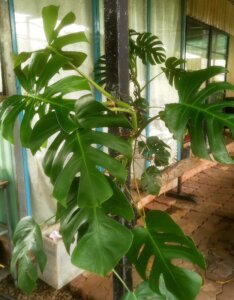Basic Information
Monstera Borsigiana is a popular indoor plant with distinctive “Swiss cheese” leaves. This blog explores the best practices to keep it thriving, turning your home into a lush sanctuary. Let’s discover how to keep your leafy companion healthy and stunning for years!



Light
Monstera Borsigiana thrives in bright, indirect light. Direct sunlight should be avoided as it may cause leaf burn. This plant prefers dappled light, similar to that found under a jungle canopy. To provide the ideal conditions, place the plant near an east-facing window that receives at least 6 hours of sunlight daily. In winter, use grow lights to ensure adequate light.
Water
Watering Monstera Borsigiana requires a balanced approach. The top 2-3 inches of soil should dry out before watering again. Overwatering can lead to root rot, a common issue with Monsteras. It’s best to water deeply until it drains through the bottom, then empty any excess from the tray. You might water more frequently during warmer months but always check the soil moisture first.
Soil
Monstera Borsigiana needs well-draining, nutrient-rich soil. A mix containing peat, perlite, and organic matter, such as compost, works well. The soil should retain moisture without becoming waterlogged. For those who overwater, adding extra perlite can improve drainage. Regular soil refreshing is vital to provide essential nutrients for your plant’s growth.
Temperature
The ideal temperature range for Monstera Borsigiana is between 65°F (18°C) and 80°F (27°C). While it can tolerate slightly cooler temperatures, growth slows down below 65°F, and frost is a definite no-go. Keep your plant away from drafts and sudden temperature changes to maintain steady growth.
Humidity
Monstera Borsigiana thrives in medium to high humidity, reflecting its tropical origins. In dry environments, consider using a humidifier, misting the plant, or placing it on a pebble tray with water. It’s crucial to avoid placing it near air vents or fans, as these can reduce humidity and harm the plant.
Fertilizer
Fertilize your Monstera Borsigiana monthly during the growing season (spring through summer) with a balanced, diluted fertilizer. A higher nitrogen content can promote leaf growth, but be cautious with the amount to avoid fertilizer burn. In winter, reduce or stop fertilizing as the plant’s growth slows.
Tip: A balanced 20-20-20 fertilizer promotes lush green foliage.
Growth Rate
Monstera Borsigiana is a moderately fast grower, especially in ideal conditions. It can reach impressive sizes with proper care, adding a dramatic touch to any interior. Regular pruning and repotting (every 2-3 years) will help manage its size and encourage healthy growth.
Pet Safety
Monstera Borsigiana is toxic to pets. Keep it out of reach to avoid accidental nibbling.
Grow in Semi-Hydro
- Monsteras, known for their robust growth and iconic split leaves, flourish in semi-hydroponics systems like LECA/Pon, thanks to their adaptive root systems and love for moisture.
- Transitioning Monstera to semi-hydroponics is effective with a Nutrient Stagnant Wicking (NSW) setup, ensuring a stable and efficient growth environment.
- In LECA/Pon, Monstera roots quickly adjust, overcoming any initial challenges with root adaptation in the NSW system.
- A nutrient mix with a concentration of about 800-1000ppm is ideal for fertilizing Monsteras in semi-hydro setups.
- Monsteras are adaptable to various temperature and humidity conditions, making them suitable for growth in diverse indoor environments.
- Ongoing care includes regular monitoring of the water level in the reservoir and periodic flushing of the system to promote healthy and continuous growth.
Tips
- Rotate the plant occasionally for even growth.
- Wipe the leaves with a damp cloth to remove dust and promote photosynthesis.
- Use a stake or moss pole for support as the plant grows.
- Be vigilant for signs of pests like spider mites or mealybugs.
- Trim any yellow or damaged leaves to keep the plant healthy.
- Propagate through stem cuttings or air layering to multiply your Monstera family.
- Monitor soil moisture with a finger test or moisture meter for accurate watering.
To care for Monstera Borsigiana, find the right balance of light, water, and humidity. With regular maintenance, it will be a long-lasting addition to your indoor garden. Enjoy the verdant ambiance it creates!
Happy planting! 🌱


